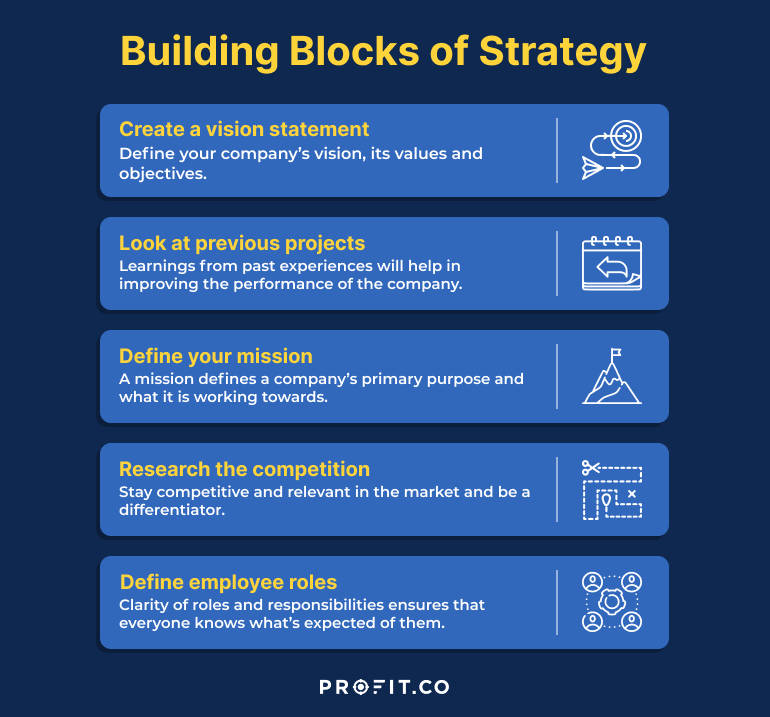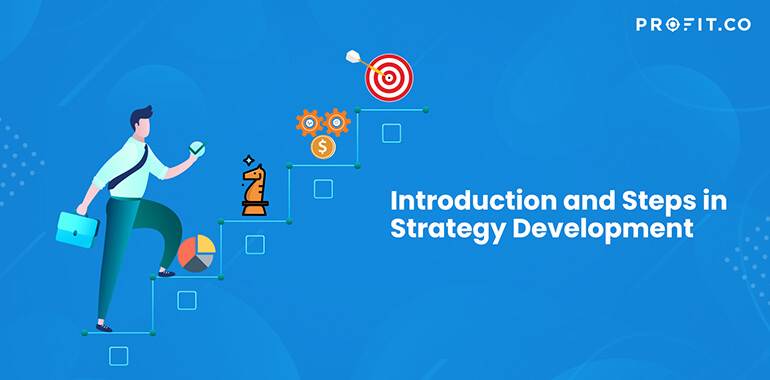What is strategy development?
Strategy development identifies strategic options to help an organization grow and accomplish its goals. It involves deciding what resources are needed and how to allocate them to help actualize these objectives.
The strategy development process details how the team plans to achieve the goals. It also includes the company’s vision and mission to ensure that all employees are aligned with the company’s goals and know what they are working towards. The strategy development process may take a few months.
Definition of strategy
Strategy is the overall direction an organization takes to achieve business success. Strategy defines how an organization will utilize its resources, both skills, knowledge of its employees, and financial and material resources to meet its vision and goals.
Why do you need a strategy for your business?
Your strategy for your business is often your guiding light. It tells you whether you’re on the right track or headed in the right direction. It helps you evaluate and re-evaluate your approach and correct it if you’re veering off track. Regardless, your organization’s success depends on your strategy.
Let’s take a look at how strategy comes into play for your business:
- A strategy helps plan the future but does not determine the future
- A strategy makes sure every employee’s actions are aligned
- A strategy acts as the north star
strategy is figuring out what not to do
1. A strategy helps plan the future but does not determine the future
The future is uncertain for everyone. Especially when it’s an environment where so many things can change in a short period of time. There’s so much ambiguity to deal with. This is where strategy helps. While it doesn’t ensure a future, it helps set the guidelines for what to do, when, and how to do it.
2. A strategy makes sure every employee’s actions are aligned
People working together or individually could be very busy and productive for their team or department. But that doesn’t necessarily mean that team, department, or company is performing well too, and it’s pretty likely that they are not working in alignment and the same direction. A strategy ensures that everybody’s actions and objectives are headed in the same direction and benefits everyone and the entire organization.
3. A strategy acts as the north star
A strategy is a plan and a north star that helps an organization and its employees with a guide. Strategy helps, especially when things are going awry and turbulent times. It’s easy to lose sight of what’s essential when caught up in the daily busyness of work, and a strategy helps stay rooted in reality and to stay focused.
When do you need new strategy development?
The state of your business determines your strategic decisions. If you’re in control of your strategy, you will know what to do and when what works best for your business. That said, you may or may not need a new strategy development, you can tweak your existing strategy if you are faced with new challenges. But at the end of the day what you need to bear in mind is if your strategy helps you quickly course correct, seize new opportunities, and stay relevant in the industry, that’s all that matters. If your existing strategy helps you do that, great. If not, tweak the existing strategy or develop a new one. Organizations can use an agile software to mange the strategy in a systematic manner. Book a free demo with our team to learn more about how OKR software can optimize your organization’s strategy!

What are the building blocks of strategy?
1. Create a vision statement
Creating a vision statement is one of the first steps that you need to take toward building your strategy. Define your company’s vision, and what are its values and objectives. The vision statement should clearly articulate what your company goals are and every team member must know what it is.
2. Look at previous projects
Learnings from past experiences and projects can be immensely helpful in improving the performance of employees and in turn, that of the company. Making a list of the most successful projects and what made them so successful, and also making a note of all the unsuccessful projects and what made them unsuccessful, can help with planning future projects and what the desired outcome should be.
3. Define your mission
Define your company’s mission statement. A mission defines a company’s primary purpose and can be very detailed so that everyone knows what the organization is working towards.
4. Know your competition
Know who your competition is, and be sure to know who the top 10 competitors are. Never lose sight of them. Know what they are doing and what’s leading them to their success, or downfall. This information will help your organization to stay competitive and relevant in the market. Add value to your brand by creating a differentiator for yourself; it could be in the form of a product or service or in brand positioning.
5. Define employee roles
One of the main reasons for defining the vision and mission is for every employee to be aligned with the company’s goals. That said, every employee should contribute to achieving company goals. Defining clear roles and responsibilities for employees ensures that everyone knows what’s expected of them.
What does a good strategy look like?
- Having a strategic roadmap in place
- A strategy that empowers employees
- A dynamic business strategy
1. Having a strategic roadmap in place
A good strategy starts with a good strategy roadmap. A strategy roadmap, as the name suggests, maps the course for employees. Once the strategy roadmap is in place, it becomes easier to execute, especially when you know what needs to be executed.
2. A strategy that empowers employees
The right strategy empowers the employees and is automatically an inclusive approach that gives employees reason and meaning. Not only does the organization benefit from the performance, but the employees are benefitted too. Ultimately, it would help unlock their potential and it’s just onward and upward from thereon.
3. A dynamic business strategy
A good business strategy is dynamic, adaptive, and accessible to everyone in the organization business. A good strategy isn’t something that you set once and forget about. Strategy development is an ongoing and collaborative process that aims to constantly optimize every step of the way from the planning phase to successful execution.
Three tips that will make your strategy effective are:
- Be true to your self
- Prepare to adapt
- Your people are your most important resource
While it’s paramount to represent and achieve for your organization, it should not be at the cost of your identity or values. Know what your strengths and skills are and use them to your advantage too while you use it to your organization’s advantage.
Be flexible. Don’t be too rigid about your ways of working. Know that we live in a very dynamic world and things change on the fly. Be prepared to adapt and change your ways when the situation demands it.
Never forget that your people are your most important resource. Nothing else matters as much as your people do. Your people are what make your vision a reality. Put their needs first, and they’ll go above and beyond to do more for the strategy and vision of the organization.
In Conclusion
Strategy development in today’s environment is no mean feat. But the organizations that invest the time and effort in strategy development and strategy formulation are hands down way ahead of those that don’t. They are surely building businesses of the future. It increases their chances of building a successful business, and helps stay relevant in the industry for years to come. To bridge the gap between strategy and execution You can get started on Profit.co’s OKR software completely free today!

